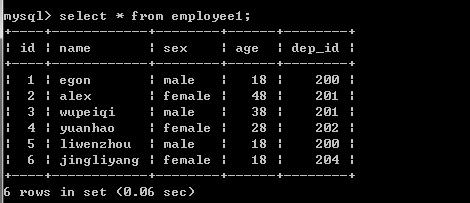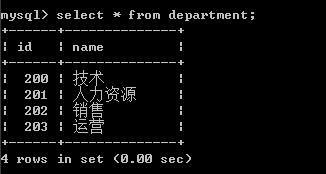MySQL数据库之单双表查询
Posted 呜咽的时光喵
tags:
篇首语:本文由小常识网(cha138.com)小编为大家整理,主要介绍了MySQL数据库之单双表查询相关的知识,希望对你有一定的参考价值。
单表查询
先创建表
#创建表 create table employee( id int not null unique auto_increment, name varchar(20) not null, sex enum(\'male\',\'female\') not null default \'male\', #大部分是男的 age int(3) unsigned not null default 28, hire_date date not null, post varchar(50), post_comment varchar(100), salary double(15,2), office int, #一个部门一个屋子 depart_id int ); #查看表结构 mysql> desc employee; +--------------+-----------------------+------+-----+---------+----------------+ | Field | Type | Null | Key | Default | Extra | +--------------+-----------------------+------+-----+---------+----------------+ | id | int(11) | NO | PRI | NULL | auto_increment | | name | varchar(20) | NO | | NULL | | | sex | enum(\'male\',\'female\') | NO | | male | | | age | int(3) unsigned | NO | | 28 | | | hire_date | date | NO | | NULL | | | post | varchar(50) | YES | | NULL | | | post_comment | varchar(100) | YES | | NULL | | | salary | double(15,2) | YES | | NULL | | | office | int(11) | YES | | NULL | | | depart_id | int(11) | YES | | NULL | | +--------------+-----------------------+------+-----+---------+----------------+ #插入记录 #三个部门:教学,销售,运营 insert into employee(name,sex,age,hire_date,post,salary,office,depart_id) values (\'egon\',\'male\',18,\'20170301\',\'teacher\',7300.33,401,1), #以下是教学部 (\'alex\',\'male\',78,\'20150302\',\'teacher\',1000000.31,401,1), (\'wupeiqi\',\'male\',81,\'20130305\',\'teacher\',8300,401,1), (\'yuanhao\',\'male\',73,\'20140701\',\'teacher\',3500,401,1), (\'liwenzhou\',\'male\',28,\'20121101\',\'teacher\',2100,401,1), (\'jingliyang\',\'female\',18,\'20110211\',\'teacher\',9000,401,1), (\'jinxin\',\'male\',18,\'19000301\',\'teacher\',30000,401,1), (\'成龙\',\'male\',48,\'20101111\',\'teacher\',10000,401,1), (\'歪歪\',\'female\',48,\'20150311\',\'sale\',3000.13,402,2),#以下是销售部门 (\'丫丫\',\'female\',38,\'20101101\',\'sale\',2000.35,402,2), (\'丁丁\',\'female\',18,\'20110312\',\'sale\',1000.37,402,2), (\'星星\',\'female\',18,\'20160513\',\'sale\',3000.29,402,2), (\'格格\',\'female\',28,\'20170127\',\'sale\',4000.33,402,2), (\'张野\',\'male\',28,\'20160311\',\'operation\',10000.13,403,3), #以下是运营部门 (\'程咬金\',\'male\',18,\'19970312\',\'operation\',20000,403,3), (\'程咬银\',\'female\',18,\'20130311\',\'operation\',19000,403,3), (\'程咬铜\',\'male\',18,\'20150411\',\'operation\',18000,403,3), (\'程咬铁\',\'female\',18,\'20140512\',\'operation\',17000,403,3) ;

1.注意: select * from t1 where 条件 group by 分组字段 1.分组只能查询分组字段,要想查看其余的利用聚合函数 2.聚合函数的分类:count,min,max,avg,group_concat,sum等。 3.模糊匹配:用like关键字。 select * from t1 where name like \'%eg%\'; #%表示任意字符 select * from t1 where name like \'d__l\'; #一个下划线表示一个字符,两个下划线就表示两个字符 4.拷贝表 :create table t2 select * from t1; create table t2 select * from t1 where 1=2 ;
一.查询语法
SELECT 字段1,字段2... FROM 表名
WHERE 条件
GROUP BY field
HAVING 筛选
ORDER BY field
LIMIT 限制条数
二.简单查询
#简单查询 SELECT id,name,sex,age,hire_date,post,post_comment,salary,office,depart_id FROM employee; SELECT * FROM employee; SELECT name,salary FROM employee; #避免重复DISTINCT SELECT DISTINCT post FROM employee; #通过四则运算查询 SELECT name, salary*12 FROM employee; SELECT name, salary*12 AS Annual_salary FROM employee; SELECT name, salary*12 Annual_salary FROM employee; #定义显示格式 CONCAT() 函数用于连接字符串 SELECT CONCAT(\'姓名: \',name,\' 年薪: \', salary*12) AS Annual_salary FROM employee; CONCAT_WS() 第一个参数为分隔符 SELECT CONCAT_WS(\':\',name,salary*12) AS Annual_salary FROM employee;
小练习:
1 查出所有员工的名字,薪资,格式为 <名字:egon> <薪资:3000> select concat(\'<名字:\',name,\'> \' ,\'<薪资:\',salary,\'>\' ) from employee; 2 查出所有的岗位(去掉重复) select distinct depart_id from employee; 3 查出所有员工名字,以及他们的年薪,年薪的字段名为年薪 select name,salary*12 年薪 from employee;
三.where约束
where字句中可以使用:
1. 比较运算符:> < >= <= <> !=
2. between 80 and 100 值在10到20之间
3. in(80,90,100) 值是80或90或100
4. like \'eg%\'
可以是%或_,
%表示任意多字符
_表示一个字符
like \'e__n\' :
5. 逻辑运算符:在多个条件直接可以使用逻辑运算符 and or not
#1:单条件查询 SELECT name FROM employee WHERE post=\'sale\'; #2:多条件查询 SELECT name,salary FROM employee WHERE post=\'teacher\' AND salary>10000; #3:关键字BETWEEN AND SELECT name,salary FROM employee WHERE salary BETWEEN 10000 AND 20000; SELECT name,salary FROM employee WHERE salary NOT BETWEEN 10000 AND 20000; #4:关键字IS NULL(判断某个字段是否为NULL不能用等号,需要用IS) SELECT name,post_comment FROM employee WHERE post_comment IS NULL; SELECT name,post_comment FROM employee WHERE post_comment IS NOT NULL; SELECT name,post_comment FROM employee WHERE post_comment=\'\'; 注意\'\'是空字符串,不是null ps: 执行 update employee set post_comment=\'\' where id=2; 再用上条查看,就会有结果了 #5:关键字IN集合查询 SELECT name,salary FROM employee WHERE salary=3000 OR salary=3500 OR salary=4000 OR salary=9000 ; SELECT name,salary FROM employee WHERE salary IN (3000,3500,4000,9000) ; SELECT name,salary FROM employee WHERE salary NOT IN (3000,3500,4000,9000) ; #6:关键字LIKE模糊查询 通配符’%’ SELECT * FROM employee WHERE name LIKE \'eg%\'; 通配符’_’ SELECT * FROM employee WHERE name LIKE \'al__\';
四.having过滤
having和where语法上是一样的。
select * from employee where id>15; select * from employee having id>15;
不同点:
#!!!执行优先级从高到低:where > group by > 聚合函数 > having >order by 1.where和having的区别 1. Where 是一个约束声明,使用Where约束来自数据库的数据,Where是在结果返回之前起作用的 (先找到表,按照where的约束条件,从表(文件)中取出数据),Where中不能使用聚合函数 2.Having是一个过滤声明,是在查询返回结果集以后对查询结果进行的过滤操作 (先找到表,按照where的约束条件,从表(文件)中取出数据,然后group by分组, 如果没有group by则所有记录整体为一组,然后执行聚合函数,然后使用having对聚合的结果进行过滤), 在Having中可以使用聚合函数。 3.where的优先级比having的优先级高 4.having可以放到group by之后,而where只能放到group by 之前。
验证:
1.查看员工的id>15的有多少个 select count(id) from employee where id>15;#正确,分析:where先执行,后执行聚合count(id), 然后select出结果 select count(id) from employee having id>15; #报错,分析:先执行聚合count(id),后执行having过滤, #无法对id进行id>15的过滤 #以上两条sql的顺序是 1:找到表employee--->用where过滤---->没有分组则默认一组执行聚合count(id)--->select执行查看组内id数目 2:找到表employee--->没有分组则默认一组执行聚合count(id)---->having 基于上一步聚合的结果(此时只有count(id)字段了) 进行id>15的过滤,很明显,根本无法获取到id字段
小练习
1. 查询各岗位内包含的员工个数小于2的岗位名、岗位内包含员工名字、个数 select post,group_concat(name) 员工姓名,count(id) 个数 from employee group by post having count(id)<2; 2. 查询各岗位平均薪资大于10000的岗位名、平均工资 select post,avg(salary) from employee group by post having avg(salary)>10000; 3. 查询各岗位平均薪资大于10000且小于20000的岗位名、平均工资 select post,avg(salary) from employee group by post having avg(salary) between 10000 and 20000;
五、分组查询 group by
大前提:可以按照任意字段分组,但分完组后,只能查看分组的那个字段,要想取的组内的其他字段信息,需要借助函数
单独使用GROUP BY关键字分组 select post from employee group by post; 注意:我们按照post字段分组,那么select查询的字段只能是post,想要获取组内的其他相关信息,需要借助函数 GROUP BY关键字和group_concat()函数一起使用 select post,group_concat(name) from employee group by post;#按照岗位分组,并查看组内成员名 select post,group_concat(name) as emp_members FROM employee group by post; GROUP BY与聚合函数一起使用 select post,count(id) as count from employee group by post;#按照岗位分组,并查看每个组有多少人
强调:
分组:一般相同的多的话就可以分成一组(一定是有重复的字段)
小练习:
1. 查询岗位名以及岗位包含的所有员工名字 select post,group_concat(name) from employee group by post; 2. 查询岗位名以及各岗位内包含的员工个数 select post,count(id) from employee group by post; 3. 查询公司内男员工和女员工的个数 select sex,count(id) from employee group by sex; 4. 查询岗位名以及各岗位的平均薪资 select post,max(salary) from employee group by post; 5. 查询岗位名以及各岗位的最高薪资 select post,max(salary) from employee group by post; 6. 查询岗位名以及各岗位的最低薪资 select post,min(salary) from employee group by post; 7. 查询男员工与男员工的平均薪资,女员工与女员工的平均薪资 select sex,avg(salary) from employee group by sex;
六、关键字的执行优先级(重点)
重点中的重点:关键字的执行优先级 from where group by having select distinct order by limit
1.找到表:from
2.拿着where指定的约束条件,去文件/表中取出一条条记录
3.将取出的一条条记录进行分组group by,如果没有group by,则整体作为一组
4.如果有聚合函数,则将组进行聚合
5.将4的结果过滤:having
6.查出结果:select
7.去重
8.将6的结果按条件排序:order by
9.将7的结果限制显示条数
七、查询排序order by
按单列排序 SELECT * FROM employee ORDER BY salary; SELECT * FROM employee ORDER BY salary ASC; SELECT * FROM employee ORDER BY salary DESC; 按多列排序:先按照age排序,如果年纪相同,则按照薪资排序 SELECT * from employee ORDER BY age, salary DESC; ===========order by========== 1.select * from employee order by salary;#如果不指定,默认就是升序 2.select * from employee order by salary asc; 3.select * from employee order by salary desc; #先按照年龄升序,当年龄相同的太多,分不清大小时,在按照工资降序 4.select * from employee order by age asc, salary desc;
多表查询
一.介绍
首先先准备表
员工表和部门表
#建表 create table department( id int, name varchar(20) ); create table employee1( id int primary key auto_increment, name varchar(20), sex enum(\'male\',\'female\') not null default \'male\', age int, dep_id int ); #插入数据 insert into department values (200,\'技术\'), (201,\'人力资源\'), (202,\'销售\'), (203,\'运营\'); insert into employee1(name,sex,age,dep_id) values (\'egon\',\'male\',18,200), (\'alex\',\'female\',48,201), (\'wupeiqi\',\'male\',38,201), (\'yuanhao\',\'female\',28,202), (\'liwenzhou\',\'male\',18,200), (\'jingliyang\',\'female\',18,204) ;
查看


二、多表连接查询
1.交叉连接:不适用任何匹配条件。生成笛卡尔积、
select * from employee1 ,department;
2.内连接:找两张表共有的部分,相当于利用条件从笛卡尔积结果中筛选出了正确的结果。(只连接匹配的行)
#找两张表共有的部分,相当于利用条件从笛卡尔积结果中筛选出了正确的结果 #department没有204这个部门,因而employee表中关于204这条员工信息没有匹配出来 select * from employee1,department where employee1.dep_id=department.id; #上面用where表示的可以用下面的内连接表示,建议使用下面的那种方法 select * from employee1 inner join department on employee1.dep_id=department.id; #也可以这样表示哈 select employee1.id,employee1.name,employee1.age,employee1.sex,department.name from employee1,department where employee1.dep_id=department.id;

注意:内连接的join可以忽略不写,但是还是加上看起来清楚点

3.左连接:优先显示左表全部记录。
#左链接:在按照on的条件取到两张表共同部分的基础上,保留左表的记录 select * from employee1 left join department on department.id=employee1.dep_id; select * from department left join employee1 on department.id=employee1.dep_id;


4.右链接:优先显示右表全部记录。
#右链接:在按照on的条件取到两张表共同部分的基础上,保留右表的记录 select * from employee1 right join department on department.id=employee1.dep_id; select * from department right join employee1 on department.id=employee1.dep_id;


5.全外连接:显示左右两个表的全部记录。
注意:mysql不支持全外连接 full join
强调:mysql可以使用union间接实现全外连接
select * from employee1 left join department on department.id=employee1.dep_id union select * from employee1 right join department on department.id=employee1.dep_id;

三、符合条件连接查询
示例1:以内连接的方式查询employee和department表,并且employee表中的age字段值必须大于25,
即找出公司所有部门中年龄大于25岁的员工
select * from employee1 inner join department on employee1.dep_id=department.id and age>25;
示例2:以内连接的方式查询employee和department表,并且以age字段的升序方式显示
select * from employee1 inner join department on employee1.dep_id=department.id = and age>25 and age>25 order by age asc;
四、子查询
#1:子查询是将一个查询语句嵌套在另一个查询语句中。 #2:内层查询语句的查询结果,可以为外层查询语句提供查询条件。 #3:子查询中可以包含:IN、NOT IN、ANY、ALL、EXISTS 和 NOT EXISTS等关键字 #4:还可以包含比较运算符:= 、 !=、> 、<等
以上是关于MySQL数据库之单双表查询的主要内容,如果未能解决你的问题,请参考以下文章
